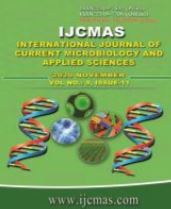


 National Academy of Agricultural Sciences (NAAS)
National Academy of Agricultural Sciences (NAAS)

|
PRINT ISSN : 2319-7692
Online ISSN : 2319-7706 Issues : 12 per year Publisher : Excellent Publishers Email : editorijcmas@gmail.com / submit@ijcmas.com Editor-in-chief: Dr.M.Prakash Index Copernicus ICV 2018: 95.39 NAAS RATING 2020: 5.38 |
Sali rice areas were mapped from multispectral LISS IV images of Resourcesat-2A satellite by using standard visual interpretation technique. The study showed that sali rice was cultivated in 102574.3 ha area which is 4.6% of the total geographical area of Meghalaya and it is distributed in all 39 blocks of 11 districts of the state. Sali rice cultivation is highest in West Garo Hills district that cover 21.9 % area and lowest in South West Khasi Hills district (2117.5 ha/2.1%). Selsella block is having the highest sali rice growing areas followed by Betasang and Zikzak block. The lowest area is found in Pynursla block of East Khasi hills district. Based on rice growing ecosystem of Meghalaya, it is found that cultivation of low altitude rice is highest in the state that cover 64.2% area followed by mid altitude (20%) and high altitude rice (15.8%). It is also observed that the low altitude rice is the highest in West Garo Hills and lowest in the South West Khasi hills district. Mid altitude rice is highest in West Jaintia Hills and Ribhoi district where as high altitude rice is found only in Khasi and Jaintia hills.
 |
 |
 |
 |
 |